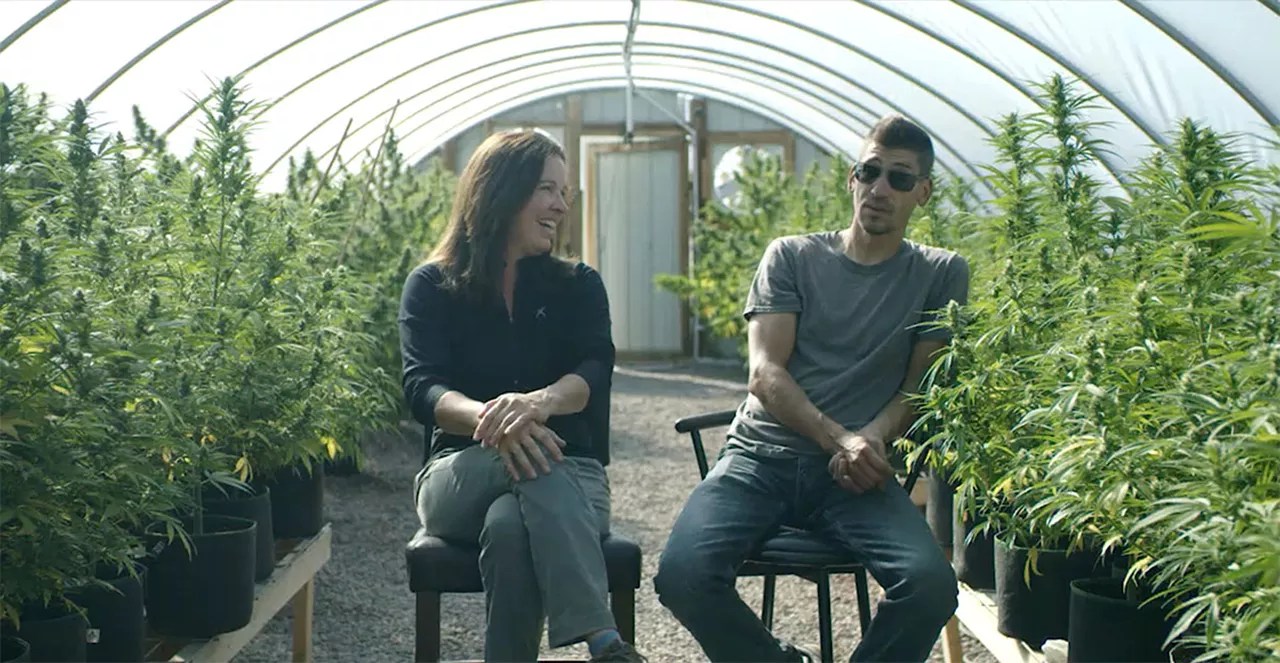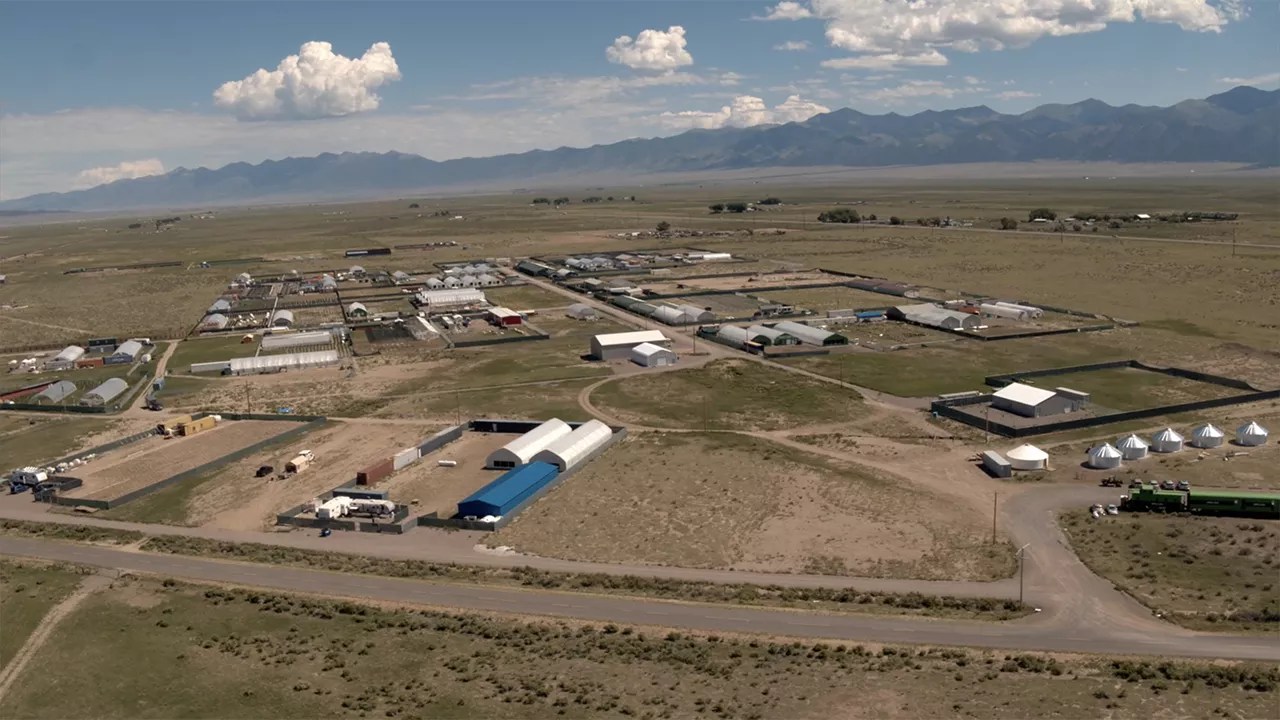
Jay Vollmar

Audio By Carbonatix
Mike Biggio unpins a map from the wall and places it on a table. With a single finger, he traces the lines that show the march of the cannabis industry on the outskirts of Moffat – a town in Colorado’s San Luis Valley that, until recently, had a population of fewer than 120 people.
“So, this is the original town,” he says, circling a clump of lots hugging State Highway 17. Then his finger veers west. “This portion, this little triangle here, is Phase One. This is Phase Two and Phase Three. We recently acquired another sixty acres that we annexed into town, and we’re going to be using that for solar.”
Biggio is sitting in his office inside a bright-green railroad car, one of several old train cars that have been repurposed as the headquarters for Area 420, the company developing a complex of marijuana farms at Moffat’s back door. The cars are an odd sight, but no odder than the rest of Phase One, a hundred-acre spread of greenhouses, shipping containers, RVs and porta-potties, construction equipment, grain bins being converted into housing, labs, security cameras, and fences covered in green mesh, accessed by gravel roads with winky-wink names like Mary Jane Lane, Dunn Deal Drive and Shakedown Street. Surrounded by high desert and flanked by the Sangre de Cristo range, the place has an otherworldly, improvisational feel to it, as if an alien invasion force had set up camp amid the saltgrass and greasewood.
The groundwork for Area 420 was laid in 2018, when Biggio and his partner in the project, developer Whitney Justice, persuaded Moffat’s town board to approve the first in a series of annexations of their company’s property that would add 420 acres to the town’s tax rolls. The annexations enabled Biggio and Justice to get out from under some pesky county regulations and allowed them to tap into the municipal water supply; although the land they had acquired and planned to sell to growers had its own private well, it was inadequate for the level of marijuana cultivation they had in mind.
Four years later, Area 420 now has close to eighty licensed grow operations, producing thousands of plants and millions in annual revenue. But the current level of activity is merely a warm-up, as far as Biggio is concerned. He envisions the San Luis Valley becoming a mecca of cannabis tourism, similar to California’s wine country, with Area 420 at its center. Visitors could tour a grow, shop at a smorgasbord of dispensaries, sample the wares at a consumption lounge, stay in fancy hotels and lounge in hot springs. All that’s necessary to get the ball rolling, he says, is some “rebranding” that would serve to alert the world to what’s going on in the valley – starting with changing the name of Moffat to Kush.
Biggio’s rebranding idea has been met with more than a few guffaws, but he says he’s deadly serious about it. The valley climate produces a cannabis crop not unlike that found in the Hindu Kush region of central Asia, he explains, and putting Kush, Colorado, on the map would draw weed connoisseurs from far and wide.
“The whole point of this is not just to be cute,” he insists. “I’ve been calling this the Kush region of the United States since I started this project.”When Biggio unveiled his immodest proposal in early June, it drew bemused headlines from CNN, National Public Radio, the Washington Post, and other national and international media outlets. But it also triggered much outrage and pushback in tiny Moffat. Many locals first learned about the proposal from an article in the Denver Post and showed up in force at a raucous town board meeting to denounce the idea.
“I don’t care what you guys do,” said one man who’d lived in Moffat eleven years, addressing the newcomers from the grow operations. “It’s a free country. But I don’t need some dope smokers to come into town and tell me that there’s something wrong with the name of the town I live in.”
Even some residents who had been generally supportive of the cannabis industry have found themselves re-evaluating their position. “I want you journalists to learn how to spell this: Fuck No, with a capital F, on the name change,” town board member Ken Skoglund tells Westword. “It’s not necessary. It’s not proper. It’s Mike Biggio’s ego. It’s just a publicity stunt, and it’s caused a whole lot of animosity in town.”

Area 420 founders Whitney Justice (left) and Mike Biggio.
coloradoarea420.com
Members of Skoglund’s family have lived in Moffat for half a century. He was one of the boardmembers who voted in favor of the Area 420 annexation, figuring it would boost the town’s beleaguered economy. His excavation company was one of the beneficiaries of the project, landing the contract to build the roads that crisscross the development, which were paid for by Justice. But the push for Kush rubs him and many other longtime citizens of Moffat the wrong way. “Most of the locals didn’t really care what they were doing out there until they dragged everybody into the name change,” he says.
Skoglund may be the lone voice of dissent on the board – which, since the annexation, has come to be dominated by Area 420-friendly forces. Three of the six boardmembers work for or have a financial interest in grow operations, and a fourth is married to a grower. The mayor, Cassandra Foxx, has spoken out in favor of the name change, describing it as a gesture of respect for “a new industry that is keeping the town alive.” In a town the size of Moffat, it takes only a handful of signatures to petition for a name change, and Biggio is expected to submit such a petition to the board in the next few weeks. If it passes muster, the petition would then be sent to the secretary of state for review, to be followed by a public hearing on the matter.
Biggio expects smooth sailing. He argues that the town of Moffat is too easily confused with Moffat County in northwest Colorado and that the town has little in the way of a name-brand identity worth saving. “There is no heritage here,” he declares. “The railroad’s long gone. People call it Methy Moffat. That’s what it’s known for. If ever there was a town that needed a rebrand, this is it.”
“I don’t need some dope smokers to tell me there’s something wrong with the name of the town I live in.”
Whether the proposal succeeds or not, many locals see the name-change controversy as a symptom of a larger problem: the rapid rise of the cannabis industry in the valley, a cultural and economic shift that local governments have been slow to address and that has left residents feeling overwhelmed. One of the poorest counties in the state, Saguache County is ill-equipped to handle the influx of new arrivals, some of whom are living in makeshift conditions and working in gray-market operations that are far less transparent than those at Area 420. Lack of resources and land-use regulations, lack of local law enforcement and lack of civic engagement are often blamed for creating a situation that seems to be spiraling out of control.
“There’s no land management at all,” says Michael Klein, a filmmaker and security consultant who’s divided time between Denver and the Moffat area for thirty years. “All these people who have no home are moving up to the hills, living in old mines, pitching tents.”
Klein worked for years with county officials to develop regulations that require residences in unincorporated areas to have a sewage disposal system, “but it means nothing,” he says. “I can point out a hundred people who have no septic system. You can go anywhere here and camp. It’s the wild West.”
Licensed grow operations, including Area 420, have attracted other kinds of complaints: odors, light pollution, traffic, dust, trash and more. Biggio maintains that his operation meets state requirements and is tidier than many old-timers’ yards in town. He encourages his growers to live on the property – in RVs, converted grain bins and tiny houses – with the aim of registering them as Moffat voters, ensuring that the pro-420 crowd outnumbers the opposition.
Developer Justice, who lives in Snowmass Village, says her company has taken no official position on the name change. “I have nothing to do with it,” she says. “It’s not appropriate for a woman in the Aspen area to tell people who live 200 miles away what to call themselves. There are people who would like to capitalize on the green rush that’s happening there. I understand that, but I’m neither for it nor against it.”
Biggio isn’t a Moffat resident, either; these days he lives in Salida, a 45-minute drive away. But as someone who once spent time in prison for growing weed, he sees the battle over Moffat’s identity in somewhat starker terms than do many of his foes. He talks about social equity issues in the cannabis trade, about how much he enjoys working with growers who are trying to “transition from the gray market” into a legal grow. Establishing the town of Kush is a declaration of sorts, a way of extending legitimacy to people who, like him, were once considered outlaws.
“We’re trying to define a new culture,” he says. “This is the first time guys like us have been able to come out of the shadows and do things legally.”

Justice and Biggio persuaded Moffat officials to annex their “cannabis business park,” which now has close to eighty licensed growers.
coloradoarea420.com
The town of Moffat is named after David Halliday Moffat, a banker and railroad tycoon whose efforts to improve Denver’s access to transcontinental rail routes eventually led to the construction of the Moffat Tunnel, a six-mile tunnel under the Continental Divide leading to Winter Park. Moffat died in 1911, the same year that the town of Moffat was incorporated, but by then, train service had made the town a major hub in the San Luis Valley for nearby mining, ranching and farming communities.
At one point the Moffat area boasted a population of 2,500 and a brass band that greeted visitors as they disembarked from the passenger trains that arrived twice a day. But the town’s heyday was brief. The mines stopped producing. Farms dried up, the water rights sold or diverted. The railroad reduced service and then suspended it altogether. By 1950, Moffat had slipped into a sleepy half-life, its population hovering around a hundred or so. That’s where it remained for decades – until Mike Biggio came to town.
Born in Queens, New York, Biggio moved to Colorado with his family in 1986 at the age of six. He spent much of his adolescence in juvenile detention or special “camps” for troubled youth. “I was a knucklehead as a kid,” he says. “I ended up going to juvie at the age of fourteen. I had an assault charge, and me and a couple of older kids broke into a hardware store.”
At eighteen, Biggio was looking at serious prison time on another assault case. He turned to the pot business, he says, as a way to cover his legal bills. He was soon facing additional charges after police raided his grow house. They also uncovered a smuggling network Biggio had developed to bring weed to Colorado from British Columbia – an operation that, at its height, was reportedly moving a hundred pounds a week. In 2000, he pleaded guilty to marijuana cultivation and was sentenced to eight years in the Colorado Department of Corrections.
He served his time and emerged into a strange new world. What had once been a grave offense, punishable by years behind bars, was now legal – and drawing a scrum of investors and ganjapreneurs. Biggio struggled to adapt to the changing landscape. He started a company to help ex-cons find employment and served on a re-entry task force, but the 2008 recession wiped out many grants and programs. He slid into a job at a medical marijuana dispensary, but then the state changed the rules so that someone with his record couldn’t work there. He purchased property in Elbert County and started a grow there but ran afoul of regulators. That time he took a deal that put him on probation for two years.

As a partner in Area 420, Mike Biggio is no longer operating from the shadows.
Alan Prendergast
In 2012, Colorado voters approved Amendment 64, authorizing retail sales of recreational marijuana, and the floodgates opened. Biggio started hearing stories about how the San Luis Valley was the next big thing. A buddy told him he had to check out Crestone. “They’re trimming weed on Main Street,” his friend reported. “The cops don’t give a shit here.”
Biggio checked out Crestone, an artist colony and spiritual center, but found it too esoteric for his tastes. “It’s a free-range mental institution,” he scoffs. “Not a place to do business.”
He started a medical grow on county land, then bought a property in Moffat and built a greenhouse in the yard. Quizzed by the then-mayor about his intentions, he took his caregiver paperwork to the next town board meeting to prove he was following the law. Looking around the sparsely populated room, it occurred to him that there were opportunities in Moffat that should be explored.
“The town was barely a town,” he recalls. “They didn’t have any money. They could barely fill the board. But they had a lot of commercial irrigation water.”
A bombastic pro-420 documentary on YouTube asserts that Moffat had $27 in its treasury before the cannabis business “saved” the town. Locals say that’s simply not true, that the town was solvent and managing to get by before Biggio’s arrival. (Moffat businesses include two marijuana dispensaries, a coffee shop, a restaurant, a Dollar General store and a $17.5 million K-12 school building that opened in 2015, paid for by a local bond issue and state funds.) It is true, though, that Moffat lacks funds for a municipal sewer system or a water treatment plant, and that the town has struggled to find enough citizens willing to serve on its board of trustees. The last three board elections, including one last spring, have been canceled because there were no contested seats; typically, boardmembers are simply appointed to fill vacancies. Moffat has also had trouble retaining a town clerk – the only full-time, salaried town employee – and has run through town attorneys like so many Wet-Naps. Last year the board issued an ordinance abolishing a proposed planning commission – “which, for all intents and purposes, does not exist in the Town due to a lack of citizen participation in municipal governance.”
“They’re trimming weed on Main Street. The cops don’t give a shit here.”
Biggio had no trouble obtaining a seat on the town board himself; he filled a position that became vacant when his predecessor, upset that the town was becoming receptive to the cannabis industry, tendered his resignation. He served for a little more than a year, until his multiple activities in the area, including acting as a liaison for other growers seeking land and water rights, presented too many conflicts of interest. But learning how the board worked helped Biggio figure out how to pursue his main ambition: finding a suitable property with sufficient water that he could sell in one-acre parcels to other growers. “The play was to get the town to approve me to access one of the municipal wells,” he says.
The plan fell into place after Biggio met Justice, a retired residential developer who was looking to invest in cannabis in the San Luis Valley. (Area 420’s Shakedown Street is a nod to Justice, an avid Deadhead.) The purchase of what would become Area 420 had barely been concluded when county officials imposed a moratorium on new marijuana grows. Undeterred, Biggio and Justice decided to seek annexation of the property by the town of Moffat, an arrangement that would allow them to skirt county restrictions. “They did us the greatest favor ever by putting in that moratorium,” Biggio says now.
The deal hammered out with town officials gave Area 420 the kind of partnership with local government that many corporations lust for. The company agreed to pay the costs of extending water and power lines and roads to the new development and for improvements to a municipal well; in return, the operation obtained access to cheap municipal water and a certain degree of protection from county interference. Attorneys for one group of residents impacted by the annexation blasted it as a “Faustian economic deal” and “a blatant attempt to work around and undermine county land-use restrictions.” County officials challenged the annexation process in court, but a judge ruled in the town’s favor.

Railcars house a recording studio and Area 420 offices next to grain bins being converted into housing.
Alan Prendergast
Patricia Reigel, the town’s mayor at the time of the annexation, says that her board decided to approve the deal because of the benefits Area 420 promised to bring to the town – not only more jobs and excise taxes, but new facilities, too. “They were supposed to put in a laundromat, a shower facility and a restroom for the town,” she says. “I didn’t imagine they would violate their own agreements.”
Biggio denies that Area 420 made any such commitments. “The former mayor was attempting to extort us into doing that,” he says.
But public records indicate that the hoped-for comfort station was more than just idle chat. In early meetings with the board, Justice explained that she was exploring several possibilities for mixed-use development of the property, including a gas station, a car wash, a recreation center and a laundromat. She suggested that the marijuana grows would be limited to the north side of the tract and that other, non-cannabis-related businesses would be located closer to the existing town and school. A 2018 agreement signed by Justice and Mayor Reigel states that the town’s approval of the initial annexation is conditional on, among other things, the creation of a “community utility center for the use of the general public,” which would contain bathrooms, a shower and a laundry. Discussion of the promised facility continued well into 2019, but reference to it was deleted from subsequent annexation agreements.
Justice denies that her company failed to meet any of its obligations. She says she attempted to deliver a check for the utility center on several occasions, only to be thwarted by Reigel’s efforts to change the terms of the deal. The bathrooms and laundry are now being built on Area 420 land, she reports.
“We have lived up to every promise we made,” she says. “Many things happened with the government that sent us into a tailspin. The mayor charged us tens of thousands of dollars of fees that were fictitious. She was just making up fees. This goes into a whole level of corruption that I never encountered before.”
At one point, Justice and Biggio felt so well-disposed toward Reigel that they named a road in the grow area in her honor: Mayor Patricia Reigel Boulevard. But the relationship soured quickly, especially after a convoluted incident in which the mayor and town compliance officers were accused of removing equipment from Area 420 on behalf of an ex-employee of a grow, who claimed the items belonged to him. Charges of official misconduct against Reigel were later dismissed.
Citing health reasons, Reigel resigned as mayor in 2020. Her departure came amid considerable upheaval in Moffat over the annexation and heated disputes between the mayor and town board members, some of whom also resigned. One source of the squabbles was the increasing array of potential and actual conflicts of interest the board was facing. Every small-town governing body has some inherent conflicts to grapple with, but the Moffat situation couldn’t be solved by an occasional recusal. The town board was also the local licensing authority for the grow operations, and there were many ways that members could personally benefit from the industry they were supposed to regulate. Skoglund’s road work was just one example; another boardmember worked as a consultant, helping growers with their licensing applications, while others were in the process of obtaining cultivation licenses themselves.
Barely a month after Reigel stepped down, the new mayor, Cassandra Foxx, signed off on an emergency ordinance shifting Moffat’s marijuana licensing duties from the town board to the town clerk. The change meant that licensed marijuana growers could now serve on the town board without breaking a state law that bans licensees from being members of a licensing authority.
“There are members of the community who would like to serve on the Board of Trustees but are currently prohibited from serving under State Law as they are ‘badged,'” the ordinance noted.
And just like that, the growers were in the driver’s seat.

Moffat Mayor Cassandra Foxx favors changing the town’s name to Kush.
coloradoarea420.com
According to Biggio, Area 420’s growers are difficult to pigeonhole. They include experienced cultivators who’ve gone independent after laboring in the factories of “corporate cannabis,” as well as newcomers to the field who are fleeing the urban chaos of the pandemic. They are former restaurant workers, laid-off techies, back-to-the-land neo-hippies and hard-nosed businesspeople who, like Biggio, used to operate in the shadows.
Most of them come from outside Colorado. Some come from other countries. A few have invested hundreds of thousands of dollars in elaborate technology, while others have scraped together just enough for a bare-bones outside grow, with the hope of moving the operation indoors after a good harvest or two. Area 420 sells them land at a price of $250,000 an acre – 20 percent down, in-house financing available, and a half-price discount for those who qualify as “social equity clients.” Buildout and licensing costs are the client’s worry, but Biggio maintains that his “cannabis park” is one of the cheapest points of entry into commercial cultivation.
The individual growers may be hard to categorize, but their collective presence is felt by their neighbors in Moffat in many ways, from the increased traffic and loud music occasionally emanating from the compound to more subtle cultural influences. When Area 420 boosters discovered that Moffat’s date of incorporation was April 20, 1911, they took it as a stroke of kismet – and license to promote the stoner-sacred numbers at every turn. Earlier this year, the mayor and the town board agreed to set their compensation at a monthly rate of $420 each. The town hall wi-fi password is, yep, Townhall420.
A posting by the mayor on a community Facebook page, seeking applicants for the position of town clerk, featured a giant bundle of weed occupying an office chair. “I wanted to make sure that we got cannabis-friendly applicants,” Mayor Foxx says. “We deal with a lot of cannabis regulation, and we need somebody who’s going to be comfortable with that.”
A paralegal who works in Monte Vista, Foxx is an unabashed booster of the name change. A few weeks ago, she posted a giddy video of herself announcing that she “just got off the phone with CNN” – which was criticized in some quarters for lacking mayoral decorum. She also recently appeared in an Area 420 promotional video that features a fair amount of keg-draining and spliff-firing, albeit not by her.
“I like growth,” Foxx says. “I like change. I understand it’s a hard thing for a lot of people. But nothing good in life happened because everybody was comfortable.”
Some changes are harder to accept than others. The open consumption of marijuana around town hasn’t been much of an issue, except when it occurs during breaks in board meetings. “Last night I had to ask one of the boardmembers to open a window because we were getting hotboxed in there,” says Dawn Lee Mayo. “I don’t think the smell of pot is as bad as cigarettes, but I think it’s inappropriate at a public meeting.”
A teacher and sister of boardmember Skoglund, Mayo is probably the town’s most outspoken opponent of Biggio’s proposal. She says that she’s received threats for her activism and that others have been intimidated into silence: “There are people who won’t even come out of their house. They don’t want to speak about it for fear of retaliation.”

Roads through the complex are named to honor the green rush.
Alan Prendergast
Several longtime residents spoke to Westword about the controversy but requested anonymity. They raised concerns about the potential costs of changing the town’s name, from altering signage and legal documents to rerouting Social Security checks; the impacts it will have on the 650 people who live in the Moffat zip code but don’t live in the town limits; the challenge of trying to attract non-cannabis businesses to a town called Kush; and even the image problem it presents for high school athletics. “I really don’t want to be rooting for the Kush Cowboys,” says one.
“Me and my wife are investing our life’s income into a bed-and-breakfast, and I’ll be go to hell if it’s going to be in the town of Kush.”
Biggio describes the local opposition as “grumpy old men” who “don’t want you to move a rock across the road.” He predicts that “Welcome to Kush” T-shirt sales alone will outpace any economic development project the town could devise. At the same time, he admits that the community needs more than cannabis to thrive. He says he has a letter of intent from “a billionaire investor who has twenty-something RV parks around the country. He wants to do one here – but only if we change the name to Kush, Colorado. I have another gentleman who’s interested in building a hotel, same thing.”
His opponents argue that the cannabis industry still carries a stigma that can discourage other businesses from moving to town. Skoglund says the name change could drive away buyers from a new housing development he’s planning. “Marijuana is a very large industry, but there are other things happening here as well,” he observes.
Tony Veno also sees the name change as bad for business. He came to the Moffat area in search of his retirement dream, he says, only to see it imperiled by Biggio’s big idea. “Me and my wife are investing our life’s income into a bed-and-breakfast,” he reports, “and I’ll be go to hell if it’s going to be in the town of Kush.”
A former Texan, drawn to the San Luis Valley by its “all-around beauty,” Veno has owned property in Saguache County since 2017. Moffat, he says, had everything he was looking for: “Small town. Great people. Everybody knows everybody’s name.”
Biggio’s proposal prompted Veno to take a closer look at how things worked in town. He says he’s been unable to get straight answers about the town’s finances, its shifting regulations regarding Area 420, the environmental impacts of such a large grow facility, and how the town board can continue to govern while enmeshed in so many conflicts of interest.
“You’ve got a small group of people, and I honestly don’t believe they did the research that needed to be done before allowing this annexation,” he says. “If they’re going to be the cannabis capital of the world and shove people out of this town who have been here for generations, then the town has lost its allure. I’ve had calls from two dispensaries in town, telling me they’re not going to be strong-armed by this guy. There are growers who don’t want to be part of this.”
Skoglund, too, has had conversations with growers who are skeptical of the name change. Because of his construction work, he’s had more interaction with Area 420’s clients than most townspeople. In his view, some are good neighbors, others aren’t. “Some just come in and trash out the place,” he says. “Their fences are shit, they have garbage blowing around, they have stuff stacked out in the roads. I maintain the roads, and it’s hard to run a road grader down there when they have campers, containers and vehicles in the damn road.”
A few months ago, the town hired a cannabis compliance officer, filling a position that had been vacant for more than a year. The new hire, Colin Mudd, runs a Denver-based cannabis consulting firm that works with industry clients and had Biggio’s strong backing. Biggio points out that Moffat is one of only a few municipalities to have such a post.
“I guess it’s up to us to sell more weed to bring more money into this town.”
Primary responsibility for compliance issues rests with the Colorado Department of Revenue’s Marijuana Enforcement Division. A MED spokesperson acknowledges that the division has an “open and ongoing investigation” into Area 420 licensees but declines to provide further details. Not every investigation produces evidence of violations, and the division’s reports of administrative actions taken from 2019 through the first six months of 2022 contain almost no mention of any fines or license revocations involving growers in the Moffat area. The MED has conducted 59 field inspections of Moffat cultivations in the past 42 months, as well as 40 inventory-tracking reviews – which sounds like a lot but works out to around one inspection per grow operation for that entire period of time. Biggio says the state comes knocking at Area 420 around once a year: “They’re swamped, and we’re in the middle of nowhere.”
But even in relative isolation, Area 420 is still subject to the same market forces that are facing Denver-area growers. After years of superheated growth, retail marijuana sales in Colorado have been in a months-long slump, driving prices down. Saguache County grower Kyle Grote says that it’s a case of supply exceeding demand. “There are more cultivations than there are stores,” he notes. “There’s more supply on the market right now, and that’s what has driven the price down so much.”
Launched in 2015, Grote’s operation is one of the oldest licensed marijuana farms in the valley; after years of working with major distributors, he finally was able to open his own retail shop in Villa Grove that’s attracted a steady, mostly older clientele. He’s weathered the green rush and its shakeout, a hemp crash and now the price slump. Taxes, fees and the costs of running a grow make for a much slimmer profit margin, he suggests, than most newcomers anticipate. “The market is so fragile,” he says. “You’ve got to do everything by the book in this business.”
The town of Moffat has collected close to $200,000 in excise taxes from cannabis cultivation over the past two years. The money is sitting in a bank account, awaiting a decision by the town board on how to spend it. Much of it is expected to go toward redrilling town wells and improving water quality. “We think that would be the best use of it,” Mayor Foxx says. “That, and fixing some of our more primitive roads.”
According to Biggio, improving the wells is a key to the town’s future. If Area 420 hadn’t generated the necessary revenue, “the town wouldn’t be here twenty years from now,” he declares. “Once we do this, the town is back to broke. So I guess it’s up to us to sell more weed to bring more money into this town – because nothing else is doing it.”
Justice’s company is spending hundreds of thousands of dollars on a water chlorination system that will benefit the entire town, she says: “One thing I can say is the town of Moffat needs help. I wish residents were as passionate about sewer, sanitation and water as they are about the proposed name change.”
The improvements certainly won’t hurt Area 420’s viability in a volatile industry.
Sales in Phase Two are now underway. The owners of the project are in a position similar to that of the shopkeepers who sold shovels to miners in the short-lived days of Colorado’s gold rush. Then as now, the race belongs not to the swift, but to those who collect the price of admission from winners and losers alike.